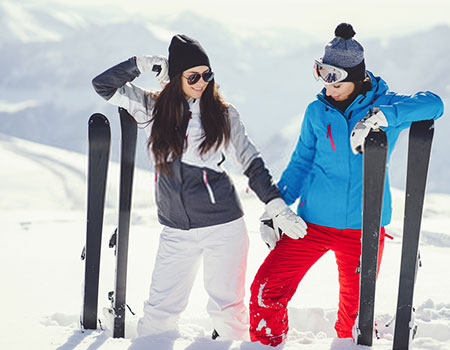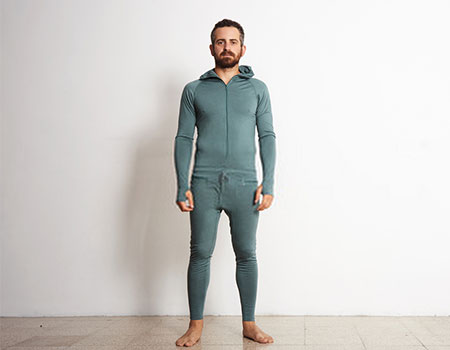
You commonly talk about current gears, technology, and sets of skis in the market if you are into skiing. But on the side, some aspects of this sport are sometimes overlooked. Like, what to Wear Under Ski Pants?
Base Layers we recommends
- Senior Compression - Our compression pants have good elasticity and durability. It...
- High-End Fabric - The high-stretch fabric tightly wraps the muscles, keeping them excited...
- Ergonomic Suture Design - Special wiring design makes the stitching seamless and smooth....
- PRODUCT FEATURES: Fitted, 27 ½" Inseam (Size M), Moisture Wicking, Anti-Odor, 4-Way...
- FABRIC: 40% Polyester - 34% Acrylic - 22% Rayon - 4% Spandex - Lightweight knit with a lot...
- CARE INSTRUCTIONS: Wash Cold Gentle Cycle With Like Colors, Non-Chlorine Bleach Only,...
- Super-light HeatGear fabric delivers superior coverage without weighing you down
- Strategic mesh panels for added ventilation where you need it
- Material wicks sweat & dries really fast
Observe new skiers or the ones who have just turned back to the sport. They will have to discover the basics of the sports. Those basics also include the dressing equipment aside from the technical ones. This aspect is crucial because you do not obviously want to freeze while enjoying the winter breeze.
In this post, we will help you understand why ski pants layering is essential, how to best wear your ski pants, and other tips for better ski pants layering techniques.
Are you ready for your next ski adventure? Then this reading is just right for you!
What is Ski Pants Layering, and Why Does It Matter?
Before we get even further, let’s first talk about ski pants layering. For stylists, layering is putting different styles topped on each for creative appearance. On the other hand, we have another context in this article.
Ski pants layering is putting a thin layer of cloth over a thicker layer. This means that proper layering ski pants have something to do with the right combination of thin and thick clothing materials. You also have to know that there is a right way or process of doing it.

That means for you to layer ski pants or winter clothes properly; the right combination is having a thin material and a thick material. There is also a proper way of doing it, and it is wearing the thick material first and layering it with a thin cloth.
It is really important to know what to wear under ski pants; it will inevitably affect your activity throughout. When you do not wear such apparel appropriately, you most probably feel discomfort and unforeseen circumstances.
What to Wear Under Ski Pants: Ski Pants
1. Type of Ski Pants
Ski Pants are more often made of thick yet lightweight materials. When you are wondering what to wear skiing the first time, you must be able to wear light pants or leggings under it. It does not have to be thermal because your ski pants will provide you the necessary insulation.
2. Type of Pants
If you want to wear pants under the ski pants, you have to put in mind proper layering. You should first wear a thicker clothing piece and layer it with a thinner one. When that is not the case for you, wear thermal pants.
Also, read: Best Ski and Snowboard Base Cleaners
Wearing thermal pants under your ski pants will make you feel warm. You can consider clothing materials made of cotton or synthetic materials for optimal use. The insulation depends on your inner pants. Your pants on top will just give extra protection.
3. Winter Activities
Skiing will be an enjoyable activity if you follow proper layering techniques. But, if you are up for a little fun, ski pants only are still great. When hiking, wearing underpants below ski pants will assist in your actions and movements preventing sprain.

What to Wear Under Ski Pants: Best Base Layer Fabrics
The primary suggestion for base fabrics is to choose one that keeps moisture from the skin. This is because it will less likely affect your body temperature.
Ski base layer pants must leave the insulation task to the outer layer because you don’t want to feel unwanted cold or warmth. This means that the base layer maintains the default body temperature, and the chance of sweating inside your pants is lesser.
You can choose from cotton, leggings, or other synthetic items like spandex for the base. On extremely cold days, wool is also recommended. Though wool generates heat, it prevents the moisture from sticking around, making it another right choice.
You must also check for the base layer with:
- Non-restrictions
- Moisture-wicking
- Breathable layering
What to Wear Under Ski Pants: Soft Shell Recommendation
If you are considering what to wear under shell ski pants, be sure that the outer covering doesn’t have a moisture-wicking feature. The case is if you have over insulation, you will feel discomfort.
When you have soft shell pants, you should pair it with cotton leggings. The soft shell detail will be enough for keeping water or sweat away yet still retain the right temperature. Doubling it is acceptable during more massive snow seasons.
Remember that wearing double softshells can trap moisture because no layer will get rid of that moisture. So make sure to consider proper layering techniques.
How To Wear Your Ski Pants and Clothes
1. Put On the Base Layer
- Wear Thermal Top
Select a thin thermal shirt that fits your chest. Choose synthetic material, if possible. You can also consider wool, for it is an excellent option for regulating heat. Ensure that your top will not slide while you are walking.
- Wear Thermal Pants
Be sure to have thin and precisely fitted underpants. The body fit pants will give you warm protection. You may also consider choosing synthetic clothing to
Make sure these are thin and fitting balance moisture against your legs.
2. Put On the Middle Layer
- Wear Middle Layer Sweater
Put on a jacket or sweater that has half or full zipper. That one must also have a standup collar. This keeps you warmer. Check also for underarm zippers called “put vents” for allowing sweat to move away properly.
- Wear Soft Shell (Windy Condition)
The soft shells are fitting but stretch to give comfort. They are made to be wind-resistant or windproof in variations. You can look for these with waterproof coating on the surface.
- Wear Middle Layer Pants (When Necessary)
Middle layer pants maybe just optional with the current fabric trends of base and outer cloth layering. You may ask help from cloth shop staff if you are still new with this. In case you use mid-layer pants, prefer a reasonably tight one to avoid the problem on the outer clothing layer.
3. Put On the Outer Layer
- Wear Ski Jacket
Wear a ski jacket that has enough room for accommodating comfortable layering. But that must not be to lose. Be sure to have a waterproof and insulated one, not a typical sweatshirt or hoodie. Ski jackets have unique fabrics for insulation and breathable features. That also includes a powder skirt or cuffs.
- Wear Ski Pants
Wear actual ski pants that are made for slopes. This has an inner cuff sliding your boots to prevent snow from getting in. Remember to have it fit you well to all comfortable movements.
- Wear Ski Socks
Put on one pair of thin socks to keep you warm.
- Wear Ski Boots
Other boots will not clip to the skis. So, you must buy or rent a pair of boots that fit your foot width. Check out for ones with adequate flexibility. For recreational skiing, you should avoid stiff boots that are designed for races.
Tips for Good Ski Layering
- Be Simple
You might be traveling into the backcountry or headed with travel bag limitations, you will still want a layering technique that is easy to use and pack.
You must prefer lightweight layers than heavy and space-consuming materials.
You may also like: Best Backcountry Ski Backpacks
Lightweight and warm materials are best even in extreme weather conditions. Those kinds of items are designed to even for multiple wearing without a smell. They also quickly dry and can be worn every day.
- Try Pack-ability
It is given that you want to get away from cotton hoodies and thick parkas. When you start skiing through a cool morning and stay there until noon, you will need to strip some layer or two.
As you put that in your bag, those jackets that are very compressible and very lightweight are necessary for comfortable packing. You look for the kinds that have appropriate warmth and easy pack down features. That makes it more manageable to bring and effortless to put in the travel bag.
- Go With Shell Jacket
A shell a jacket is best for your spring layering. Your layers will give you warmth. Your shell will protect you from the snow, rain, and wind. It’s the primary benefit for this protective element is the guaranteed protection in any degree of temperature.
Think of a 40 degree and sunny day, you can have lightweight layering and shell to be waterproof and be slightly warm. Or if it is -4 degrees and freezing, your jacket can be closed down under your shell for the needed warmth, waterproof and wind protection.
- Have Your Insulated Vest
Vests are somehow underrated in terms of warmth. Well, insulated vests are incredibly necessary for adding warmth for a small cost. These are made for wearing close to your body.
When your body heats up, it will send warm blood to the fingers and toes. That makes the whole body warm.
An appropriate vest also prevents the bulky feeling when you wear layers of clothes. When you feel too hot, these can be simply packed and kept. They are typically balled up, which are recommended for small packs or even the pocket.
- Remember the Small Things
A hat and neck waiter is important for keeping warmth in unpredictable weather. Use or take off your hat, depending on the temperature. A neck waiter will
Hats and Neck Gait are essential for keeping warm on a wacky-weather day. Add a hat or take it off depending upon your heat. A neck waiter will improve your feeling as it will boost heat, keep the wind from your neck, and stop the snow from getting to your shell.
These little items are needed if you look for booting the quality and performance of a layering jacket.
Other Skiing Essentials
- Sunblock and lip balm
You can still get sunburn even in cold weather, so you must put sunblock on your skin. You can choose an SPF level depending on your skin fairness.
Also, have time to put lip balm to maintain the moisture on your lips.
- Ski gloves
Make sure your ski gloves are specifically designed for skiing. This is another protection for your hand and wrist.
- Goggles
Use this to protect your eyes from snow blindness and other flying debris. This also helps in navigating through cloudy conditions.
- Helmet
A helmet is also very significant. This protects your head from any head injury. This is a rule of thumb that needs to be considered. You may also have a head-fitting hat under the helmet for extra warmth.
Final Say
As of this time, you have a quick view of the things about ski pants and the like. Now it is more comfortable to choose and wear the right ones for you. Remember, the factors in this post will have an effect on the over skiing adventure you desire or dream. Start it and see yourself enjoying the moment.


